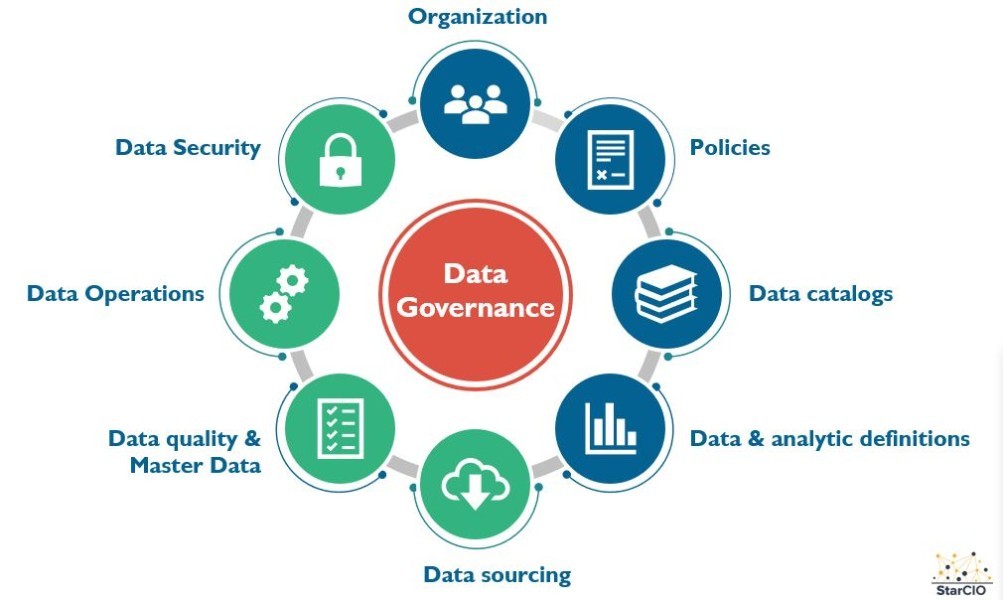Data Governance: Managing and Protecting Information Assets
- 12 Jul, 2023
- 3379 views
Data governance is a comprehensive framework and set of practices for managing and protecting an organization's information assets. It involves establishing policies, procedures, and guidelines to ensure data quality, integrity, security, and compliance throughout its lifecycle. Effective data governance enables organizations to maximize the value of their data while mitigating risks associated with its use. Here are key aspects and best practices for managing and protecting information assets through data governance:
Data Governance Framework: Establish a clear data governance framework that defines roles, responsibilities, and decision-making processes related to data management. This framework should align with the organization's overall goals, policies, and regulatory requirements. It provides a structure for data governance activities, including data ownership, accountability, and stewardship.
Data Classification and Categorization: Classify and categorize data based on its sensitivity, criticality, and regulatory requirements. This helps identify the appropriate level of protection and access controls required for different data types. Common classifications may include public, internal, confidential, and personally identifiable information (PII).
Data Privacy and Compliance: Ensure compliance with relevant data protection and privacy regulations, such as the General Data Protection Regulation (GDPR) or the California Consumer Privacy Act (CCPA). Implement policies and procedures to safeguard sensitive data, obtain necessary consents, and manage data subject rights. Regularly review and update compliance practices to address evolving regulations.
Data Security Measures: Implement robust data security measures to protect information assets from unauthorized access, data breaches, and cyber threats. This includes using encryption for data at rest and in transit, strong access controls, user authentication, intrusion detection systems, and regular security audits. Establish incident response plans to address security breaches promptly.
Data Quality and Integrity: Establish processes and controls to ensure data quality and integrity throughout its lifecycle. This involves defining data standards, validation rules, and data cleansing procedures. Regularly monitor and audit data to identify and rectify inconsistencies, errors, or duplicates. Implement data validation and verification mechanisms to maintain accuracy and reliability.
Data Retention and Disposal: Define data retention policies and schedules to determine how long data should be retained based on legal, regulatory, and business requirements. Establish procedures for secure data disposal when it is no longer needed, ensuring that sensitive information is permanently deleted or anonymized to prevent unauthorized access.
Data Access and User Management: Implement role-based access controls (RBAC) to limit access to data based on job roles and responsibilities. Regularly review user access privileges to ensure they are appropriate and aligned with business needs. Monitor and log data access activities to detect unauthorized or suspicious behavior.
Data Governance Education and Training: Provide data governance education and training to employees to raise awareness of their roles and responsibilities in managing and protecting information assets. Training programs should cover data handling best practices, security protocols, privacy requirements, and data governance policies.
Data Governance Committee: Establish a data governance committee comprising stakeholders from various business units. The committee should oversee data governance initiatives, ensure alignment with organizational objectives, review policies, address data-related issues, and promote a culture of data stewardship and accountability.
Continuous Monitoring and Improvement: Data governance is an ongoing process. Regularly monitor and measure data governance activities and key performance indicators (KPIs) to assess effectiveness and identify areas for improvement. Continuously review and update data governance policies and practices to adapt to evolving business needs, technological advancements, and regulatory changes.
By implementing robust data governance practices, organizations can effectively manage and protect their information assets. This not only helps ensure compliance with regulations but also improves data quality, supports informed decision-making, and enhances trust among stakeholders.
- Category:
- Arts & Culture
- No comments



